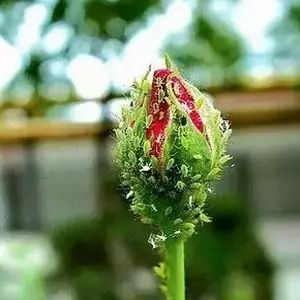
Rose powdery mildew and aphid control

520 is homophonic with "I love you", and it has become a festival full of fresh flowers. On the day of 520, it is natural to send roses to the people you love the most. The rose was the symbol of Aphrodite, the goddess of love in ancient Greece, and in botanical classification, roses were shrubs of the genus Rosa, which were divided into ornamental roses and edible roses.

Among them, edible roses are fragrant and pure, and can be made into rose tea by drying and processing; The petals can be made into sweet and delicious rose cakes and rose cakes. To make delicious food, it is natural to have excellent rose growing quality.
Drones guard the plateau roses
The Central Yunnan Plateau is a low-latitude plateau located in Yunnan, where the unique climate is very suitable for flower cultivation. Bajie Town, located in the Central Yunnan Plateau, has a long history of edible rose cultivation.

In the past, Bajie Town usually relied on manual carrying cartridges for operation, but due to the geographical environment, the manual carrying of cartridges was usually inefficient, and it was difficult to achieve unified control and control, resulting in repeated attacks of pests and diseases. As a result, the quality of edible roses and the income of growers are seriously affected.
The Anning Plant Protection Quarantine Station, where Bajie Town is located, has introduced plant protection drones according to regional conditions, providing accurate and efficient spraying services, which greatly reduces the operational burden of villagers.
April is the season when roses bloom, and it's also the time of year when the town of Eight Streets is sprayed with roses. On April 13~15 this year, the three teams of Yunnan Lvfei Plant Protection provided flying plant protection services for 600 acres of edible roses in the bud stage of Lianlian Village, Bajie Town.
A variety of operation modes can easily cope with complex terrain
The terrain of the planting area that needs to be operated is relatively complex, with flat land, gentle slope land and terraced fields, of which complex terrain such as gentle slope land and terraced fields account for more than half of the operation area, so the pilot adopts different operation modes for different terrains.
When working on flat ground, the route operation mode or AB point intelligent operation mode is mostly adopted, and the enhanced manual operation mode is mostly used for gentle slopes and terraces. Considering that roses are planted in clusters, the spray width is set to 3.5m when spraying.
|
Airplane mode |
F mode, P mode |
Job mode |
Route operation mode, AB point intelligent operation, enhanced manual operation |
|
Flight altitude |
1.5 meters |
Flight speed |
4 m/s |
|
Spray rate |
1.2L/min |
Job spacing |
3.5 meters |
|
The amount of pesticides applied per mu |
0.95L/mu |
Sprinkler situation |
4 nozzles |
Roses are prone to powdery mildew and aphids
The main purpose of this operation is to control rose powdery mildew and aphids. Powdery mildew is one of the common diseases on roses, and the most obvious feature is the appearance of white powdery particles on the affected parts.

The early stage of powdery mildew begins with the appearance of small white pink spots on the affected area, and then gradually expands into round or irregular powdery spots.
The aphids can reproduce for dozens of generations in a year on the rose, and by sucking the host sap, the heart leaves can not be expanded, harming the flower buds, affecting the normal opening of the flowers, and also causing the petals to leave spot marks and affect the growth of the plant. Under open-field cultivation conditions, aphids occur severely in early spring and early summer.
|
Prevention and control objects |
Powdery mildew, aphids |
Description of pests and diseases |
The incidence of powdery mildew was 30%, and the number of aphids per plant was 35 |
|
Operational terrain |
Gentle slope bottom, terraced ground, flat land |
Environmental conditions |
The temperature is 17-24°C, the humidity is 42%, and the wind is ≦ level 2 |
Plant protection drugs are particular
In view of the on-site situation, the Anning Plant Protection and Quarantine Station selected the following agents: 30% azole ether · tebuconazole and halopyranamide produced by Dow Yinong. Among them, azole ether · tebuconazole is a compound agent, containing 20% tebuconazole and 10% pyraclostrobin.

Tebuconazole belongs to the triazole fungicide, and pyraclostrobin belongs to the methoxyacrylate, and the compound of two drugs with different mechanisms of action can play a better prevention and control effect.
Halodioxapyr is a sulfoneimine insecticide launched by Dow in recent years, which can effectively control stinging and sucking mouthparts pests that are resistant to nicotinoids, pyrethroids and organophosphorus. Momentive-Jeplolite spray additives can effectively promote the spreading, adhesion and absorption of the liquid medicine in the leaves, and increase the utilization rate of the liquid medicine.
|
The name of the pesticide |
dosage form |
Active ingredient and content |
Dosage per mu |
|
Minderida-azole ether tebuconazole |
Suspension |
Tebuconazole content: 20% pyraclostrobin content: 10% |
60g |
|
Dow Yinong - Special Service |
Suspension |
Halodimidoxapyr |
15g |
|
Momento-Jayson |
Additives |
Silicones |
20g |
Job completed After being equipped with chemicals, the three teams of Lvfei Plant Protection used plant protection drones to spray operations, which lasted three days and efficiently completed the operation of 600 acres. The person in charge of the relevant agricultural department and the growers inspected the effect of the unmanned spraying operation on the spot and unanimously expressed their approval. This operation once again verified the feasibility of flying defense plant protection and the importance of realizing the unified defense rule.








